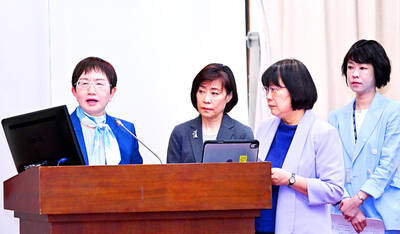LCD panel maker Innolux Corp (群創) yesterday announced that net profit last quarter reached the highest in 15 quarters and that the strong momentum should carry into this quarter, sparking a sequential increase of 15 percent in the price of TV and laptop panels.
The Miaoli-based company said that global demand for panels this quarter continues to outpace supply — as the COVID-19 pandemic has triggered a massive use of contactless technology and displays for Internet-connected electronics — which would support a continuing upward trend in panel prices this quarter, Innolux said in a statement.
People are also upgrading their electronic devices for distance learning, which has deepened an already tight panel supply, the company said.

Photo: Chen Mei-ying, Taipei Times
Shipments of TV and PC panels this quarter are expected to remain flat from last quarter, due to the limited availability of key components, from display driver ICs to glass substrates, Innolux said.
This quarter, shipments of smaller display panels, those used in handsets, are to decline by a low single-digit percentage from last quarter, the company said.
The company’s net profit for the first quarter increased 14.1 percent to NT$11.57 billion (US$413.92 million), compared with NT$10.14 billion in the previous quarter and reversing from losses of NT$5.27 billion a year earlier.
Earnings per share rose to NT$1.15, up from NT$1.04 a quarter earlier and minus-NT$0.55 a year earlier.
Average sales prices for TV and PC panels last quarter soared 48.56 percent year-on-year to US$413 per square meter, up from US$278 per square meter in the same period last year, representing a quarterly increase of 14 percent from US$362 per square meter.
Gross margin improved to 25.8 percent, up from 20.4 percent the previous quarter and minus-1.8 percent a year earlier.
Innolux’s board of directors yesterday approved an initial public offering (IPO) plan for its subsidiary InnoCare Optoelectronics Corp (睿生光電), which was spun off from the company in 2019, a regulatory filing showed.
InnoCare, with initial capital of NT$200 million, makes display panels used in medical devices.
Innolux is in the process of spinning off its automotive display panel manufacturing arm, CarUX Technology Inc (群豐駿), after it suspended a plan last year due to a slump in global vehicle sales.
This year, the company has moved several hundred employees to the Tainan-based CarUX.
The board also approved the distribution of a cash dividend of NT$0.4 per share based on last year’s earnings per share of NT$0.17, the company said, adding that it plans to allocate some of its capital surplus to fund the dividend payout.

‘SWASTICAR’: Tesla CEO Elon Musk’s close association with Donald Trump has prompted opponents to brand him a ‘Nazi’ and resulted in a dramatic drop in sales Demonstrators descended on Tesla Inc dealerships across the US, and in Europe and Canada on Saturday to protest company chief Elon Musk, who has amassed extraordinary power as a top adviser to US President Donald Trump. Waving signs with messages such as “Musk is stealing our money” and “Reclaim our country,” the protests largely took place peacefully following fiery episodes of vandalism on Tesla vehicles, dealerships and other facilities in recent weeks that US officials have denounced as terrorism. Hundreds rallied on Saturday outside the Tesla dealership in Manhattan. Some blasted Musk, the world’s richest man, while others demanded the shuttering of his

ADVERSARIES: The new list includes 11 entities in China and one in Taiwan, which is a local branch of Chinese cloud computing firm Inspur Group The US added dozens of entities to a trade blacklist on Tuesday, the US Department of Commerce said, in part to disrupt Beijing’s artificial intelligence (AI) and advanced computing capabilities. The action affects 80 entities from countries including China, the United Arab Emirates and Iran, with the commerce department citing their “activities contrary to US national security and foreign policy.” Those added to the “entity list” are restricted from obtaining US items and technologies without government authorization. “We will not allow adversaries to exploit American technology to bolster their own militaries and threaten American lives,” US Secretary of Commerce Howard Lutnick said. The entities

Minister of Finance Chuang Tsui-yun (莊翠雲) yesterday told lawmakers that she “would not speculate,” but a “response plan” has been prepared in case Taiwan is targeted by US President Donald Trump’s reciprocal tariffs, which are to be announced on Wednesday next week. The Trump administration, including US Secretary of the Treasury Scott Bessent, has said that much of the proposed reciprocal tariffs would focus on the 15 countries that have the highest trade surpluses with the US. Bessent has referred to those countries as the “dirty 15,” but has not named them. Last year, Taiwan’s US$73.9 billion trade surplus with the US

Prices of gasoline and diesel products at domestic gas stations are to fall NT$0.2 and NT$0.1 per liter respectively this week, even though international crude oil prices rose last week, CPC Corp, Taiwan (台灣中油) and Formosa Petrochemical Corp (台塑石化) said yesterday. International crude oil prices continued rising last week, as the US Energy Information Administration reported a larger-than-expected drop in US commercial crude oil inventories, CPC said in a statement. Based on the company’s floating oil price formula, the cost of crude oil rose 2.38 percent last week from a week earlier, it said. News that US President Donald Trump plans a “secondary